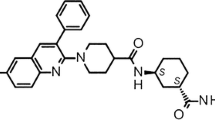Abstract
Etodolac is the first anti-inflammatory drug belonging to the tetrahydropyranoindole class. In contrast to several other common anti-inflammatory drugs, etodolac exhibited an unusually high potency as an inhibitor of established adjuvant arthritis relative to its activity against carrageenan paw edema in the rat. This phenomenon led us to investigate whether the ability of NSAIDs to inhibit prostaglandin biosynthesis differed between cultures of macrophages, which are present in inflammatory exudates, and cultures of synoviocytes and chondrocytes, which contribute to inflammation of the articulating joint. Although other anti-inflammatory drugs were found to be equally active in all three cell types, etodolac was found to be much more effective on the cells of the joint than on the macrophage. This differential activity may be responsible for the striking efficacy of etodolac as an anti-arthritic drug.
Similar content being viewed by others
References
G. B. Jacob, M. Sanda, J. F. Mullane, J. Kennedy, M. Barbetti and P. Suleski,Long-term evaluation of the efficacy and safety of etodolac in the treatment of rheumatoid arthritis. Adv. Ther.2, 82–95 (1985).
A. Norman, A. Greenspan, G. Jacob, S. Salem, M. Sanda and J. F. Mullane,Radiographic findings and evaluation of skeletal changes in patients with rheumatoid arthritis treated with etodolac and aspirin. Arth. Rheum.28, S15 (1985).
I. Salom, G. Jacob, N. Jallad, C. A. Perdomo, J. F. Mullane and D. Weidler,Gastrointestinal microbleeding associated with the use of etodolac, ibuprofen, indomethacin, and naproxen in normal males. J. Clin. Pharmacol.24, 240–246 (1984).
R. R. Martel, J. Klicius and G. Metcalf,Effect of etodolac on articular and bone pathology associated with adjuvant arthritis in rats: a comparison with aspirin and naproxen. Agents and Actions14, 257–264 (1984).
R. R. Martel, J. Klicius, G. Metcalf and G. A. Rona,Comparative effects of long term treatment with etodolac, naproxen, and ibuprofen on articular and bone changes associated with adjuvant arthritis in rats. Agents and Actions15, 403–412 (1984).
K. Brune, K. D. Rainsford, K. Wagner and B. A. Peskar,Inhibition by anti-inflammatory drugs of prostaglandin production in cultured macrophages. Naunyn-Schmied Arch. Pharmacol.315, 269–278 (1981).
J.-M. Dayer, S. M. Krane, R. G. G. Russell and D. R. Robinson,Production of collagenase and prostaglandin by isolated adherent rheumatoid synovial cells. Proc. Nat. Acad. Sci. USA73, 945–949 (1976).
M. B. McGuire-Goldring, J. E. Meats, D. D. Wood, E. J. Ihrie, N. M. Ebsworth and R. G. G. Russell,In vitro activation of human chondrocytes and synoviocytes by a human interleukin-1-like factor. Arth. Rheum.27, 654–662 (1984).
C. A. Winter, E. A. Risley and G. W. Nuss,Carrageenan-induced edema in hind paw of the rat as an assay for anti-inflammatory drugs. Proc. Soc. Exp. Biol. Med.111, 544–547 (1962).
S. T. Litchfield and F. A. Wilcoxon,Simplified method of evaluating dose effect experiments. J. Pharmacol. Exp. Ther.96, 99–113 (1949).
S. B. Mizel, J. J. Oppenheim and D. D. Rosenstreich,Characterization of lymphocyte activating factor (LAF) produced by the macrophage line P388D1. I. Enhancement of LAF production by activated T lymphocytes. J. Immunol.170, 1499–1506 (1978).
S. Bjornsson and D. Heinegard,Isolation and culture techniques of foetal calf chondrocytes. Biochem. J.198, 141–148 (1981).
B. J. Clarris, J. R. E. Fraser, C. J. Moran and K. D. Muirden,Rheumatoid synovial cells from intact joints. Ann. Rheum. Dis.36, 293–307 (1977).
D. K. Miller, S. Sadowski, D. DeSousa, A. L., Maycock, D. L. Lombardo, R. N. Young and E. C. Hayes,Development of enzyme-linked immunosorbent assays for measurement of leukotrienes and prostaglandins. J. Immunol. Methods81, 169–185 (1985).
R. G. Neuman, J. H. Korn, E. T. Lally, D. D. Wood and E. S. Kimball,An ELISA for prostaglandin E 2 utilizing monoclonal antibody. J. Immunoassay (submitted).
R. J. Flower,Drugs which inhibit prostaglandin biosynthesis. Pharmacol. Rev.26, 33–67 (1974).
J. L. Humes, S. Sadowski, M. Galvage, M. Goldenberg, E. Subers, F. A. Kuehl and R. J. Bonney,Pharmacological effects of non-steroidal antiinflammatory agents on prostaglandin and leukotriene synthesis in mouse peritoneal macrophages. Biochem. Pharm.32, 2319–2322 (1983).
M. B. McGuire-Goldring J. F. Meats, D. D. Wood, E. J. Ihrie, N. M. Ebsworth and R. G. G. Russell,In vitro activation of human chondrocytes and synoviocytes by a human interleukin-1-like factor. Arth. Rheum.27, 654–662 (1984).
D. D. Wood, E. J. Ihrie and D. Hamerman,Release of interleukin-1 from human synovial tissue in vitro. Arth. Rheum.28, 853–862 (1985).
D. Mitrovic, E. McCall, P. Front, F. Aprile, D. Darmon and F. Dray,Anti-inflammatory drugs, prostanoid and proteoglycan production by cultured bovine articular chondrocytes. Prostaglandins28, 417–434 (1984).
D. R. Robinson and M. B. McGuire,Prostaglandins in the rheumatic diseases. Ann. NY Acad. Sci.256, 318–329 (1975).
D. R. Robinson, M. B. McGuire, D. Bastian, F. Kantrowitz and L. Levine,The effects of anti-inflammatory drugs on prostaglandin production by rheumatoid synovial tissue. Prostaglandins and Medicine1, 461–477 (1978).
R. A. Sturge, D. B. Yates, D. Gordon, M. Franco, W. Paul, A. Bray and J. Morley,Prostaglandin production in arthritis. Ann. Rheum. Dis.37, 315–320 (1978).
D. C. Garg, N. S. Jallad and D. J. Weidler,Pharmacokinetics of etodolac in the elderly. Postgrad. Med. Special Report 23-27 (1985).
Author information
Authors and Affiliations
Rights and permissions
About this article
Cite this article
Neuman, R.G., Wilson, B.D., Barkley, M. et al. Inhibition of prostaglandin biosynthesis by etodolac. I. Selective activities in arthritis. Agents and Actions 21, 160–166 (1987). https://doi.org/10.1007/BF01974936
Received:
Accepted:
Issue Date:
DOI: https://doi.org/10.1007/BF01974936




